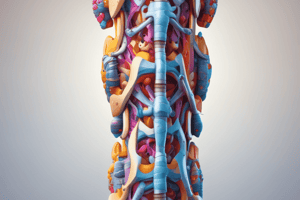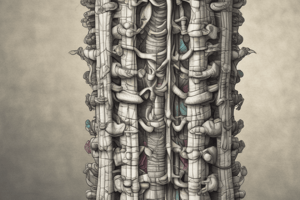Podcast
Questions and Answers
The resistance of a column with 3 flexible curvatures (like the spine) is R=10.
The resistance of a column with 3 flexible curvatures (like the spine) is R=10.
True (A)
A spinal column with exaggerated curvatures (dynamic type) has a Delmas index higher than 96%.
A spinal column with exaggerated curvatures (dynamic type) has a Delmas index higher than 96%.
False (B)
Water and proteoglycans concentrations are highest in the annulus fibrosus of the intervertebral disk.
Water and proteoglycans concentrations are highest in the annulus fibrosus of the intervertebral disk.
False (B)
Collagen fibers of the annulus fibrosus are mainly type II.
Collagen fibers of the annulus fibrosus are mainly type II.
The lamellae surrounding the nucleus of the intervertebral disk are arranged in random patterns.
The lamellae surrounding the nucleus of the intervertebral disk are arranged in random patterns.
Adjacent rings of lamellae in the intervertebral disk have collagen fibers arranged in the same direction.
Adjacent rings of lamellae in the intervertebral disk have collagen fibers arranged in the same direction.
The annulus fibers of the intervertebral disk are connected to the bone by Sharpey’s fibers.
The annulus fibers of the intervertebral disk are connected to the bone by Sharpey’s fibers.
A spinal column with normal curvatures has an index of 85%.
A spinal column with normal curvatures has an index of 85%.
Collagen fibers in the intervertebral disk resist shear and torsion when they run nearly vertically.
Collagen fibers in the intervertebral disk resist shear and torsion when they run nearly vertically.
Distraction forces are associated with movements like flexion, extension, and lateral flexion.
Distraction forces are associated with movements like flexion, extension, and lateral flexion.
Torsional forces become relevant in the intervertebral disk because fibers oriented in the direction of the slide or twist become loose.
Torsional forces become relevant in the intervertebral disk because fibers oriented in the direction of the slide or twist become loose.
The greater the ratio between disk thickness and vertebral body height, the lower the mobility of a particular segment.
The greater the ratio between disk thickness and vertebral body height, the lower the mobility of a particular segment.
The nucleus position closer to the center of the intervertebral disk enhances its role as a shock absorber.
The nucleus position closer to the center of the intervertebral disk enhances its role as a shock absorber.
Compression force from body weight and muscle contraction elevates hydrostatic pressure in the annulus fibrosus.
Compression force from body weight and muscle contraction elevates hydrostatic pressure in the annulus fibrosus.
Increased tension in the annulus fibrosus inhibits radial expansion of the nucleus in the intervertebral disk.
Increased tension in the annulus fibrosus inhibits radial expansion of the nucleus in the intervertebral disk.
Rising nuclear pressure is exerted horizontally against the endplates in the intervertebral disk.
Rising nuclear pressure is exerted horizontally against the endplates in the intervertebral disk.
The pressure within the nucleus converts the peripheral annulus fibrosus into an unstable weight-bearing structure.
The pressure within the nucleus converts the peripheral annulus fibrosus into an unstable weight-bearing structure.
Lifting a load with the knees flexed exerts more pressure on the lumbar disc compared to lifting a load with the knees straight.
Lifting a load with the knees flexed exerts more pressure on the lumbar disc compared to lifting a load with the knees straight.
Sitting in a forward-slouched position produces less disc pressure than sitting erect.
Sitting in a forward-slouched position produces less disc pressure than sitting erect.
Each apophyseal joint is formed by the articulation between opposing facet surfaces.
Each apophyseal joint is formed by the articulation between opposing facet surfaces.
Horizontal facet surfaces within apophyseal joints favor sagittal flexionextension.
Horizontal facet surfaces within apophyseal joints favor sagittal flexionextension.
Most apophyseal joint surfaces are oriented either horizontal or vertical, without any in-between orientations.
Most apophyseal joint surfaces are oriented either horizontal or vertical, without any in-between orientations.
The ratio between the vertebral body and intervertebral discs has no influence on the predominant motion at each spinal region.
The ratio between the vertebral body and intervertebral discs has no influence on the predominant motion at each spinal region.
Only shapes of the vertebrae affect the kinematics at different regions of the vertebral column.
Only shapes of the vertebrae affect the kinematics at different regions of the vertebral column.
Local muscle actions do not play a role in determining the predominant motion at each spinal region.
Local muscle actions do not play a role in determining the predominant motion at each spinal region.
The number of apophyseal joints in the vertebral column varies depending on the individual's height.
The number of apophyseal joints in the vertebral column varies depending on the individual's height.
Flashcards are hidden until you start studying



